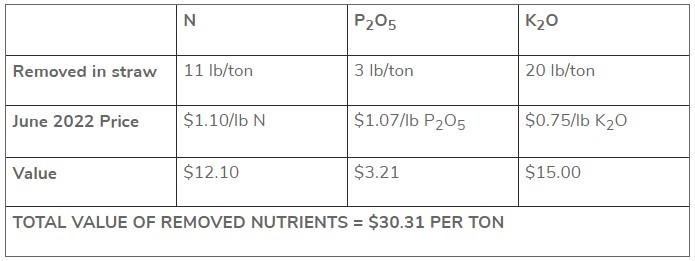By Laura Lindsey and Lee Beers et.al
Before removing the straw from the field, it’s important farmers understand the nutrient value. This is especially important now with high N, P, and K fertilizer prices. The nutrient value of wheat straw is influenced by several factors including weather, variety, and cultural practices. Thus, the most accurate values require sending a sample of the straw to an analytical laboratory. However, “book values” can be used to estimate the nutrient values of wheat straw. In previous newsletters, we reported that typically a ton of wheat straw would provide approximately 11 pounds of N, 3 pounds of P2O5, and 20 pounds of K2O. According to June 2022 fertilizer prices and nutrient removal “book values”, one ton of wheat straw would remove N, P, K valuing approximately $30.31.
Table 1. What is the value of your straw? N, P2O5, and K2O removed in straw, June 2022 fertilizer prices, and the total value of nutrients within the wheat straw.

The nitrogen in wheat straw will not immediately be available for plant uptake. The nitrogen will need to be converted by microorganisms to ammonium and nitrate (a process called “mineralization”). Once the nitrogen is in the ammonium or nitrate form, it is available for plant uptake. The rate at which mineralization occurs depends on the amount of carbon and nitrogen in the straw (C:N ratio). The USDA reports a C:N ratio of 80:1 for wheat straw which means there are 80 units of carbon for every unit of nitrogen. Mineralization rapidly occurs when the C:N ratio is ≤ 20:1. At a C:N ratio of 80:1, mineralization will be much slower. (For comparison, corn stover is reported to have a C:N ratio of 57:1.) The rate of mineralization is also influenced by soil moisture and temperature. Since mineralization is a microbial-driven process, mineralization will be slowed (halted) in the winter when temperatures are cold. Thus, no N credit is given for wheat straw since it is not known when the N will mineralize and become available to the following crop.
In addition to nitrogen, the removal of straw does lower soil potassium levels. If the straw is removed after heavy rainfall, some of the potassium may have leached out of the straw, lowering the nutrient value. However, a soil test should be done to accurately estimate nutrient availability for future crops. Besides providing nutrients, straw has value as organic matter, but it is difficult to determine its dollar value.
Source : osu.edu